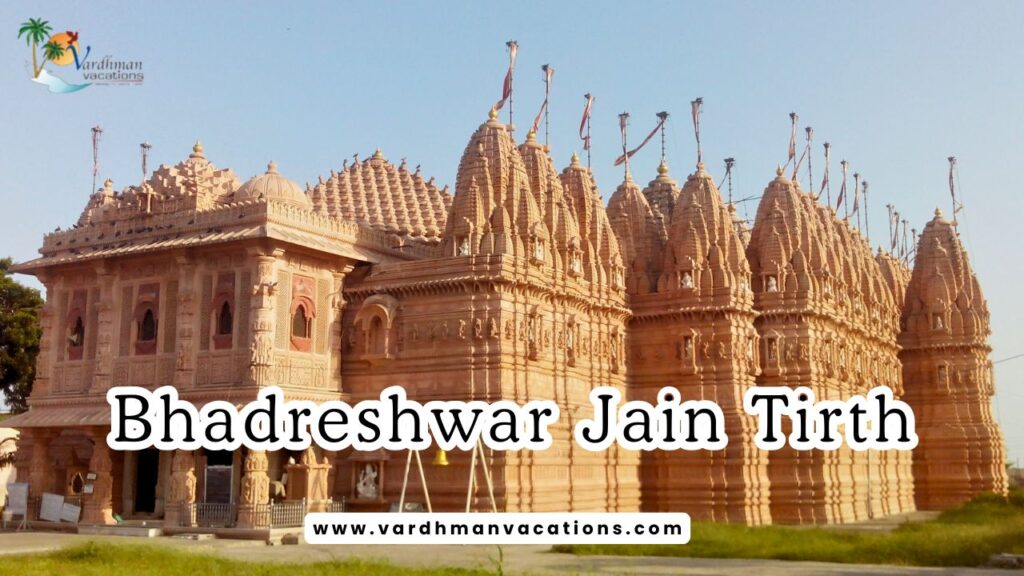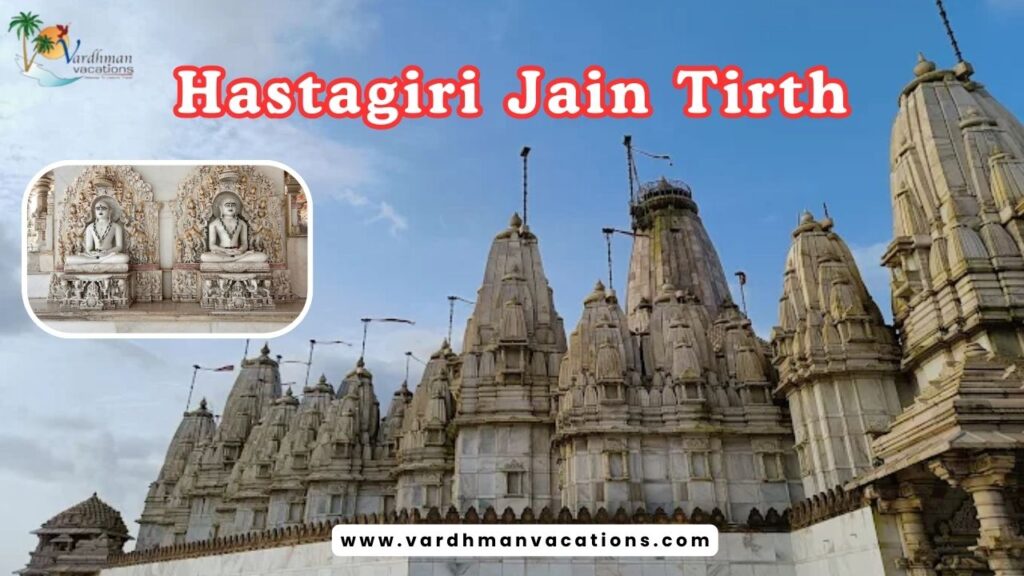October is a great time to visit Badrinath for a peaceful experience. Badrinath is located in the Chamoli district of Uttarakhand and is one of the holiest places for Hindus. The temple here is dedicated to Lord Vishnu, who is believed to have lived here in one of His forms. Every year, many devotees come to this sacred site to seek blessings.
In October, the weather in Badrinath is cool and pleasant, with clear skies and crisp air. The crowds are smaller than in the summer, making it easier to find a place to stay and to visit the temple without long lines. There is also a lower risk of landslides or heavy rain, making travel safer and more enjoyable.
With snow-capped mountains and the sound of chants, visiting Badrinath in October is a calming experience for the soul.
Things to Remember While Travelling to Badrinath in October
Badrinath Temple, one of the sacred Char Dham pilgrimage sites in Uttarakhand, is a revered shrine dedicated to Lord Vishnu in his Badrinarayana avatar. Situated at an altitude of approximately 3,100 meters in the Garhwal Himalayas, the temple holds immense historical and spiritual significance. It was established in the 8th century by Adi Shankaracharya and rests gracefully along the banks of the Alaknanda River.
The temple remains open only from May to October. Outside this window, it remains snowbound and closed to visitors. October, being the closing month of the season, is generally less crowded, offering a more peaceful and intimate spiritual experience. However, since the temple’s closing date varies each year depending on weather and religious calendars, it’s crucial to verify the schedule before planning your trip.
Travel Tips for Badrinath in October

Carry Warm Clothing: October in Badrinath can be quite chilly, especially in the mornings and evenings. Pack layers of woolens, gloves, caps, and thermal wear to stay warm and comfortable.
Transportation: The last major transport hub is Rishikesh. From there, local taxis or buses operated by experienced drivers are recommended, as the roads are steep and winding through mountainous terrain.
Scenic Beauty: October is a beautiful time to visit, with lush green mountains and clear skies creating a picture-perfect setting for your pilgrimage.
Temple Timings:
- Special Poojas: Begin from 4:30 AM (advance bookings required)
- General Darshan: Open from 7:00 AM to 1:00 PM, and again from 4:00 PM to 9:00 PM (with a 3-hour afternoon break)
Permits and Bookings: It is advisable to make all necessary bookings and acquire any required permits in advance, especially for special poojas or restricted zones.
Check Weather and Dates: Always reconfirm the temple’s opening/closing dates and the latest weather conditions before finalizing travel plans, as unseasonal snowfall can lead to early closures.
Places to Visit Near Badrinath in October
Travelling to Badrinath in October is not just about seeking divine blessings—it’s also an opportunity to explore the serene beauty of the Garhwal Himalayas. The post-monsoon season brings clear skies, lush landscapes, and cooler temperatures, making it an ideal time for sightseeing. Here are some must-visit places near Badrinath that promise a safe and memorable trip:
Vasudhara Falls – A Sacred Waterfall with Healing Powers
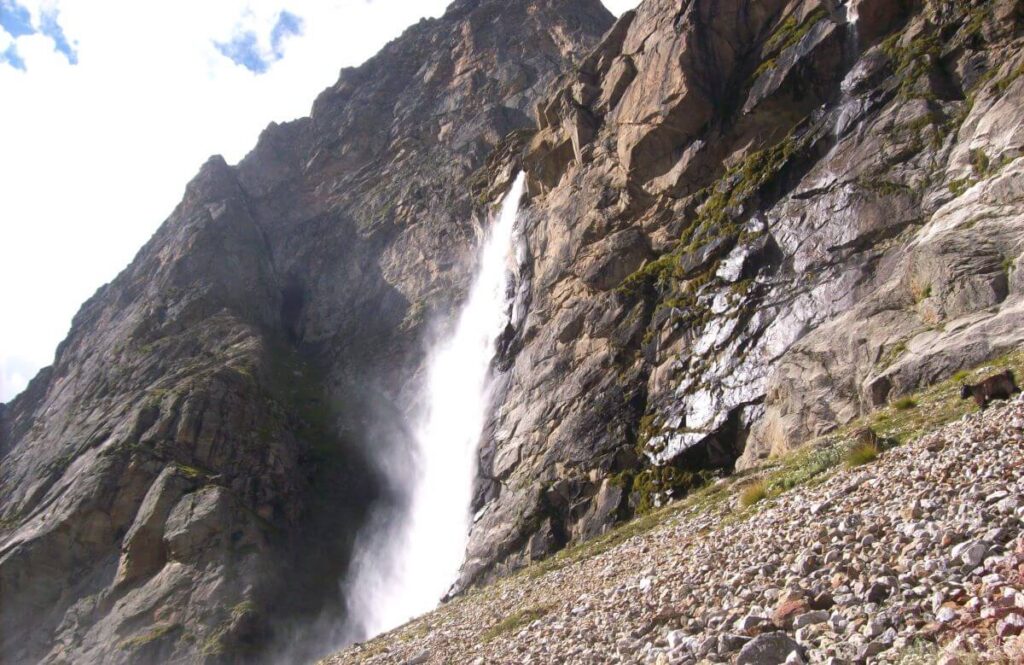
Vasudhara Falls is not just a natural marvel but also a site of deep spiritual and mythological significance. Located near Mana Village, about 9 km from Badrinath, this stunning waterfall is believed to be blessed by Lord Vishnu himself. Flowing gracefully into the Alaknanda River, Vasudhara holds a sacred place in Hindu traditions.
According to legend, this is the site where Ved Vyasa divided the Vedas, and it is said that Lord Vishnu, in the form of a river, flows through the falls. Another popular belief suggests that the water does not touch those who are impure or have committed sins—adding a mystical aura to this already enchanting destination.
Spiritual and Medicinal Importance
Devotees believe that bathing in the waters of Vasudhara cleanses the soul and body. The flow passes through regions rich in herbs and medicinal plants, giving the water natural healing properties. Pilgrims often collect this water for use in various religious rituals and poojas.
Trek to Vasudhara
- Trek Distance: ~6 km from Mana Village
- Trek Duration: Approx. 3 hours (one way)
- Trail Highlights: Foggy mountain paths, cool breeze, and panoramic Himalayan views
The trek to Vasudhara is moderately easy and ideal for beginners. With the crisp mountain air and the sound of flowing water in the distance, the journey is as rewarding as the destination itself.
How to Reach Vasudhara Falls
- Step 1: Drive 3 km from Badrinath to Mana Village (India’s last village near the Indo-Tibetan border)
- Step 2: Begin the 6 km trek from Mana to Vasudhara Falls
Timings
- Open 24 hours, but trekking is best done during daylight hours (6 AM – 5 PM)
- Best time to visit: May to October (waterfalls are inaccessible during winter due to heavy snowfall)
Brahma Kapal – A Sacred Site for Ancestral Rituals in Badrinath

Located near the Badrinath Temple on the banks of the Alaknanda River, Brahma Kapal is one of the most spiritually significant places for Hindus. This sacred site is especially revered for performing Shraddha and Pind Daan—rituals for the peace of departed souls.
Religious Significance
It is believed that Lord Brahma resides at Brahma Kapal, and performing last rites here ensures moksha (liberation from the cycle of birth and death) for the deceased. Many devotees travel here from across India to perform annual death rituals for their ancestors. According to legend, Lord Shiva once beheaded Lord Brahma, and the skull (kapala) is said to have fallen at this very spot—thus the name Brahma Kapal, meaning “Skull of Brahma.”
Ritual Practices
Pilgrims visit this sacred site to:
- Perform Pind Daan and Tarpan for deceased ancestors
- Conduct annual Shraddha ceremonies
- Offer charity and donations to the local priests and poor as part of religious customs
Many devotees also take a dip in the icy waters of the Alaknanda River, believing it cleanses them of sins and purifies the soul before rituals.
How to Reach
- Located just a short walk from Badrinath Temple
- Walk along the banks of the Alaknanda River; well-marked paths guide pilgrims to the site
Timings
- Open 24 hours, though rituals are generally performed during daylight (early morning is preferred)
Brahma Kapal is not just a place for rituals but a deeply emotional and spiritual experience, offering a chance to connect with one’s roots and pay homage to ancestors in one of the holiest towns of India.
Neelkanth Peak – The Garhwal Queen of the Himalayas
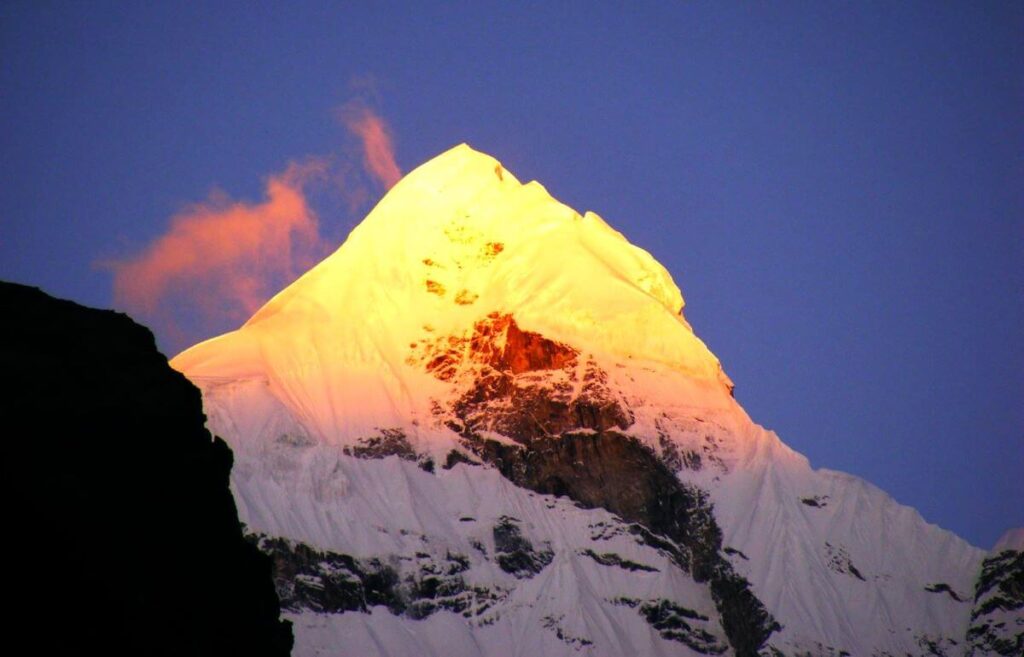
Neelkanth Peak, rising majestically to an altitude of 6,596 meters, is one of the most awe-inspiring summits in the Garhwal Himalayas of Uttarakhand. Towering above the Alaknanda River and the Badrinath Temple, this pyramid-shaped peak is often referred to as the “Queen of Garhwal” due to its breathtaking beauty and commanding presence.
A Trekker’s Paradise
The trek to Neelkanth Peak is a dream for adventure enthusiasts and experienced trekkers. The trail begins from Charan Paduka base camp in Badrinath and is known for its steep and challenging terrain. Because of the mountain’s sharp pyramid-like shape, the route demands good physical fitness and preparation.
- Best Time to Trek: June to September
- Duration: Trek takes approximately 4 to 5 hours (can vary depending on fitness and weather)
- Difficulty Level: Moderate to challenging – guided treks recommended
Due to its altitude and remote location, prior booking and planning with trekking experts or local guides is essential for a safe and successful journey.
Panoramic Beauty
Neelkanth Peak offers 360-degree panoramic views of the surrounding snow-capped mountains, making it a once-in-a-lifetime experience for nature lovers. Covered in snow for most of the year, the peak glows brilliantly during sunrise and sunset, creating a mesmerizing sight that’s hard to capture in words.
Mythological Significance
Named after Lord Shiva (Neelkanth), the peak holds spiritual importance as well. It is often considered a divine guardian watching over the sacred town of Badrinath.
How to Reach
- Step 1: Take a taxi or local transport to reach Charan Paduka, about 9 km from Badrinath
- Step 2: Begin your trek from the base camp with proper gear and guidance
Whether you’re a spiritual seeker or a mountain enthusiast, Neelkanth Peak offers a perfect blend of divinity and adventure.
Vyas Guha – The Sacred Cave of Mahabharata in Mana Village
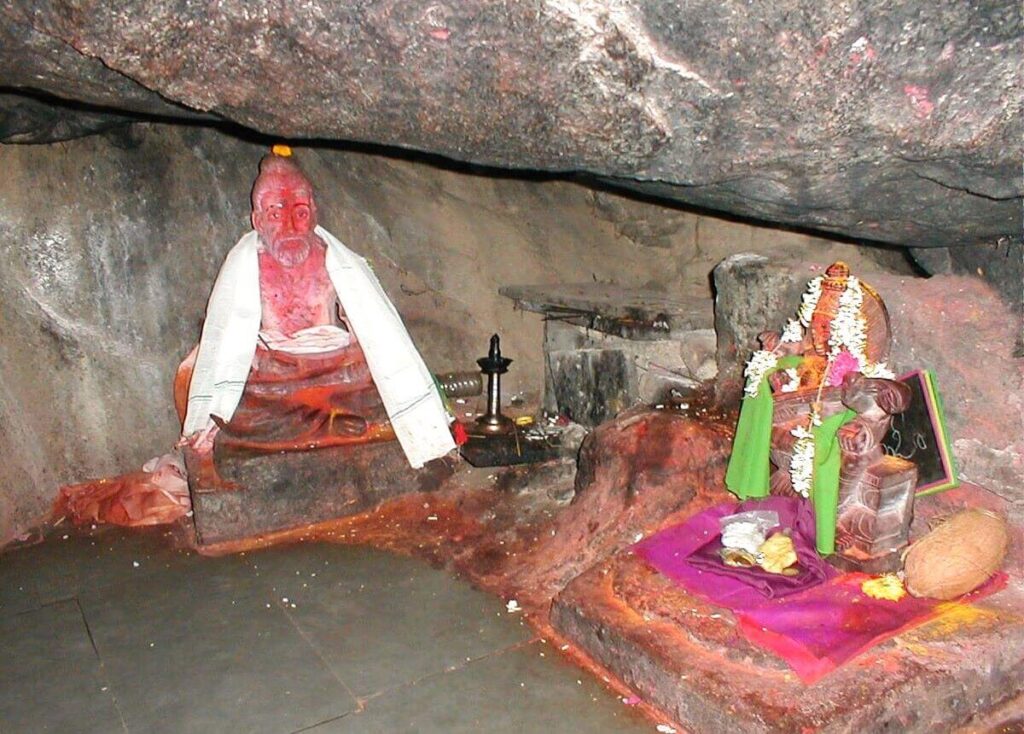
Vyas Guha (Vyas Cave), located in the Chamoli district of Uttarakhand near Mana Village, is a revered site steeped in mythology and ancient wisdom. According to Hindu belief, this is the very cave where Sage Ved Vyasa dictated the Mahabharata, while Lord Ganesha served as his scribe. Alongside the epic, it is said that Vyasa also recited the Vedas, Puranas, and the Brahma Sutras within this sacred cave.
Nestled on the banks of the Saraswati River, the cave exudes an aura of deep spirituality and calm. A small shrine inside houses an idol of Sage Vyas, which devotees worship with great reverence. Ancient manuscripts and inscriptions—though protected—add to the scholarly and spiritual significance of the site.
Spiritual and Cultural Significance
Vyas Guha is more than just a historical site; it is a spiritual sanctuary. Many believe that the origins of several holy rivers and temples in Uttarakhand trace back to this sacred spot, making it an important part of the Char Dham pilgrimage circuit.
Scenic Location
Surrounded by picturesque mountains, the cave sits amidst raw natural beauty. The gentle sound of the flowing Saraswati River, along with the sacred air of Mana—the last Indian village near the Indo-Tibetan border—creates a tranquil and reflective atmosphere for pilgrims and visitors alike.
How to Reach Vyas Guha
- By Road: Travel from Badrinath to Mana Village (~3 km by vehicle)
- By Train: The nearest railway station is Haridwar (followed by a road journey to Badrinath and Mana)
- By Trek: A short but slightly challenging trek from Mana Village leads to the cave; local guides are available for assistance
Timings
- Open 24 hours, but visiting during daylight hours (6 AM – 6 PM) is recommended for safety and best experience
Vyas Guha offers a rare blend of natural beauty, spiritual energy, and historical depth. Whether you’re a pilgrim, a seeker of knowledge, or a nature lover, this ancient cave promises an unforgettable journey into the roots of Indian philosophy and devotion.
Bheem Pul – The Mythical Bridge to Heaven in Mana Village
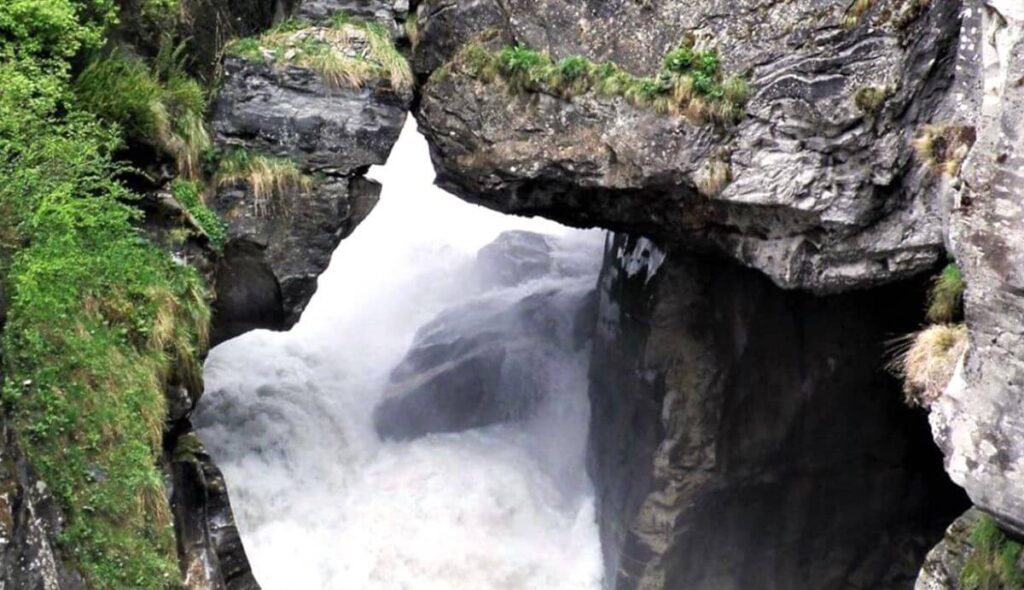
Bheem Pul, located in Mana Village, Uttarakhand, is a natural stone bridge formed over the fierce Saraswati River, just 3 km from Badrinath. This iconic spot lies close to the India-Tibet border and is steeped in mythology and spiritual significance.
According to Hindu legend, during their final journey to heaven (Mahaprasthan), the Pandavas reached this point. When Draupadi struggled to cross the roaring Saraswati River, Bheema, known for his immense strength, placed a massive rock across the river—thus forming a bridge, which today is revered as Bheem Pul.
Spiritual Significance
It is believed that this was the last earthly stop of the Pandavas, and from here, they ascended toward heaven. Even today, many devotees visit Bheem Pul to pay homage to the Pandavas, believing the site holds divine energies and spiritual passageways.
Natural Beauty and Atmosphere
Surrounded by snow-capped peaks and lush valleys, the thunderous Saraswati River flowing beneath the rock bridge creates a spectacular and almost surreal view. The landscape, combined with mythological allure, offers visitors both serenity and a profound sense of wonder.
How to Reach
- From Badrinath: Travel about 3 km by road to reach Mana Village
- From Mana, Bheem Pul is just a short walk along a clearly marked path
Timings
- Open 24 hours, but best visited during daylight hours (6 AM – 6 PM) for safety and scenic beauty
Bheem Pul is not just a place of natural charm—it is a symbol of devotion, strength, and mythological legacy. Whether you’re a spiritual seeker or a nature enthusiast, visiting this mystical bridge is an experience you won’t forget.
Final Thoughts
A visit to Badrinath in October offers not just a peaceful pilgrimage to one of India’s most sacred temples but also a chance to immerse yourself in the mystical beauty of the Garhwal Himalayas. The surrounding spots like Mana Village, Vasudhara Falls, Neelkanth Peak, Brahma Kapal, Vyas Guha, and Bheem Pul blend spiritual depth with breathtaking landscapes, making the journey truly unforgettable.
With fewer crowds, clearer weather, and the divine aura in the air, October is the perfect time to explore these hidden gems. Whether you’re a devotee seeking blessings, a trekker looking for high-altitude adventure, or a traveler chasing stories steeped in mythology, Badrinath and its surroundings have something for every soul.
So pack wisely, plan, and get ready for a serene Himalayan escape that touches both the heart and the spirit.
FAQ About Badrinath Yatra
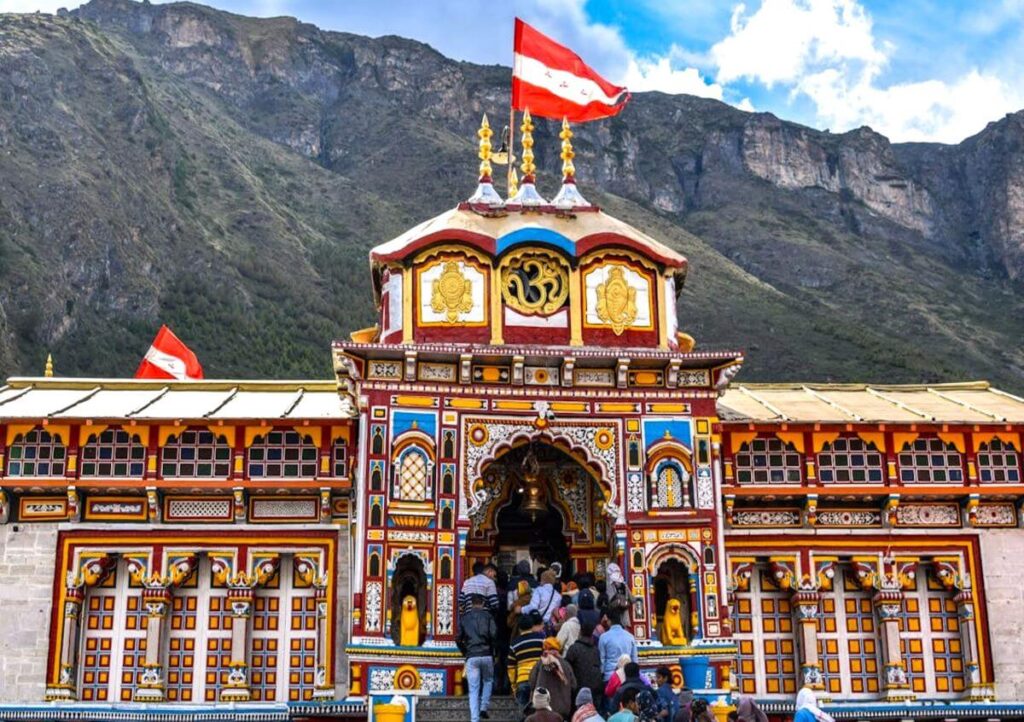
Yes, October is one of the best times to visit Badrinath. The weather is cool and pleasant, the crowds are fewer, and the chances of landslides or rain are minimal.
Yes, the temple remains open until late October. However, exact closing dates vary each year, so it’s best to confirm before planning your trip.
Carry warm clothes (layers, thermals, woolens), comfortable walking shoes, rain protection, personal medication, and basic trekking gear if planning short hikes.
Yes, many elderly devotees visit during this time. However, it’s advisable to consult a doctor beforehand and avoid long treks unless physically fit.
Yes, most treks are safe in October due to stable weather. Still, some routes can be challenging, so go with a guide or group for safety.
The nearest railway station is Haridwar, and the closest airport is Jolly Grant Airport (Dehradun). From there, taxis and buses are available to reach Badrinath via Rishikesh and Joshimath.
It takes around 2 to 3 days to explore Badrinath Temple and nearby attractions, unless you plan to go on longer treks, which may require additional time.




